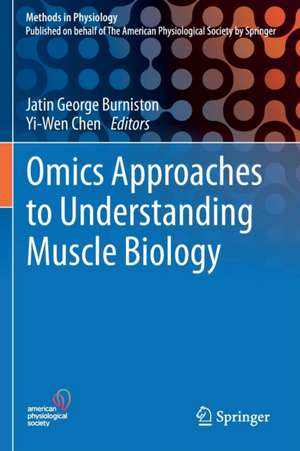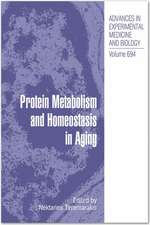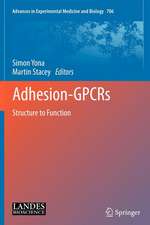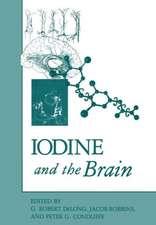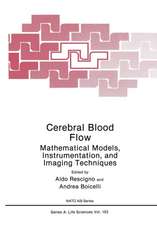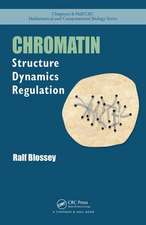Omics Approaches to Understanding Muscle Biology: Methods in Physiology
Editat de Jatin George Burniston, Yi-Wen Chenen Limba Engleză Paperback – 6 noi 2020
| Toate formatele și edițiile | Preț | Express |
|---|---|---|
| Paperback (1) | 712.09 lei 6-8 săpt. | |
| Springer Us – 6 noi 2020 | 712.09 lei 6-8 săpt. | |
| Hardback (1) | 1034.46 lei 6-8 săpt. | |
| Springer Us – 6 noi 2019 | 1034.46 lei 6-8 săpt. |
Preț: 712.09 lei
Preț vechi: 749.56 lei
-5% Nou
Puncte Express: 1068
Preț estimativ în valută:
136.30€ • 148.10$ • 114.57£
136.30€ • 148.10$ • 114.57£
Carte tipărită la comandă
Livrare economică 22 aprilie-06 mai
Preluare comenzi: 021 569.72.76
Specificații
ISBN-13: 9781493998043
ISBN-10: 1493998048
Pagini: 217
Ilustrații: VII, 217 p. 35 illus., 32 illus. in color.
Dimensiuni: 155 x 235 mm
Greutate: 0.33 kg
Ediția:1st ed. 2019
Editura: Springer Us
Colecția Springer
Seria Methods in Physiology
Locul publicării:New York, NY, United States
ISBN-10: 1493998048
Pagini: 217
Ilustrații: VII, 217 p. 35 illus., 32 illus. in color.
Dimensiuni: 155 x 235 mm
Greutate: 0.33 kg
Ediția:1st ed. 2019
Editura: Springer Us
Colecția Springer
Seria Methods in Physiology
Locul publicării:New York, NY, United States
Cuprins
Part I: Genomic and Epi-genomic.- 1) GWAS/muscle function and diseases (by Eric Hoffman).- 2) Whole genome and whole exon sequencing/muscle disorders (by Silvère van der Maarel and Richard Lemmers).- 3) Epi-genome approaches/muscle regeneration (by Vittorio Sartorelli).- Part II: Transcriptomic.- 4) RNA profiling (by Yi-Wen Chen, confirmed).- 5) miRNA profiling (by Alyson Fiorillo).- 6) Single cell profiling in muscle (byPier Lorenzo Puri).- 7) Statistics and bioinformatics (by Heather Gordish).- Part III: Proteomic.- 8). Proteome profiling of human/ clinical samples – i.e. necessarily label-free techniques (by Lawrence Mandarino).- 9) Proteome profiling of cell and animal models – i.e. label techniques such as SILAC (by Matthias Mann OR SILAM with JR Yates III).- 10) Global analysis of post-translational modifications (by David E James).- 11) Proteome dynamics – synthesis and degradation on a proteome wide scale (by Jatin Burniston, confirmed).- Part IV: Metabolomic.- 12) Non-targeted metabolomics using mass spectrometry (by Charles Burant).
Notă biografică
Jatin Burniston is a Professor of Muscle Proteomics at the Research Institute for Sport & Exercise Sciences, Liverpool John Moores University, UK. He established the first proteomics facility with a specific focus on exercise physiology and published the first works reporting proteomic analysis of striated muscle responses to exercise training. Jatin strives to continue pioneering the field of exercise proteomics and is a proud champion of the application of non-targeted '-omic' research in exercise physiology. He recently combined his expertise in mass spectrometry and proteomics with new metabolic labelling methods using deuterated/ ‘heavy’ water to establish the unique ‘Dynamic Proteome Profiling’ method. Jatin serves on the Editorial Board of the American Physiological Society (APS) journal, Physiological Genomics, and is a Fellow of the European College of Sports Sciences (ECSS) and a member of the ECSS Scientific Committee. He also leads the MSc Exercise Physiology programmeat Liverpool John Moores and particularly enjoys delivering his module on Molecular Exercise Physiology.
Yi-Wen Chen is an Associate Professor of Genomics and Precision Medicine at the George Washington University and Principal Investigator at the Center for Genetic Medicine Research, Children’s National Health System, DC, USA. Her research uses transcriptomic approaches to study molecular pathways in muscles in response to physiological stimuli and pathological conditions. Yi-Wen uses genome-wide RNA profiling to dissect the disease mechanisms of various muscle disorders and to identify molecular mechanisms of adaptive remodelling. In addition, her group uses next-generation sequencing and long-read sequencing to study genetic, epigenetic and transcriptomic changes in muscles using physiological and disease models. Currently she is part of the Human Cell Atlas consortium, with a focus on single-cell profiles and spatial characterization of gene expression in skeletal muscles at different developmental stages.
Textul de pe ultima copertă
This book is a collection of principles and current practices in omics research, applied to skeletal muscle physiology and disorders. The various sections are categorized according to the level of biological organization, namely, genomics (DNA), transcriptomics (RNA), proteomics (protein), and metabolomics (metabolite). With skeletal muscle as the unifying theme, and featuring contributions from leading experts in this traditional field of research, it highlights the importance of skeletal muscle tissue in human development, health and successful ageing. It also discusses other fascinating topics like developmental biology, muscular dystrophies, exercise, insulin resistance and atrophy due to disuse, ageing or other muscle diseases, conveying the vast opportunities for generating new hypotheses as well as testing existing hypotheses by combining high-throughput techniques with proper experiment designs, bioinformatics and statistical analyses.
Presenting the latest research techniques, this book is a valuable resource for the physiology community, particularly researchers and grad students who want to explore the new opportunities for omics technologies in basic physiology research.
Presenting the latest research techniques, this book is a valuable resource for the physiology community, particularly researchers and grad students who want to explore the new opportunities for omics technologies in basic physiology research.
Caracteristici
Comprises research, that spans all levels of biological organisation, including DNA, RNA, protein and metabolite Combines different OMICS approaches under the unifying theme of skeletal muscle physiology Broadens the understanding of big data usage in physiology research
